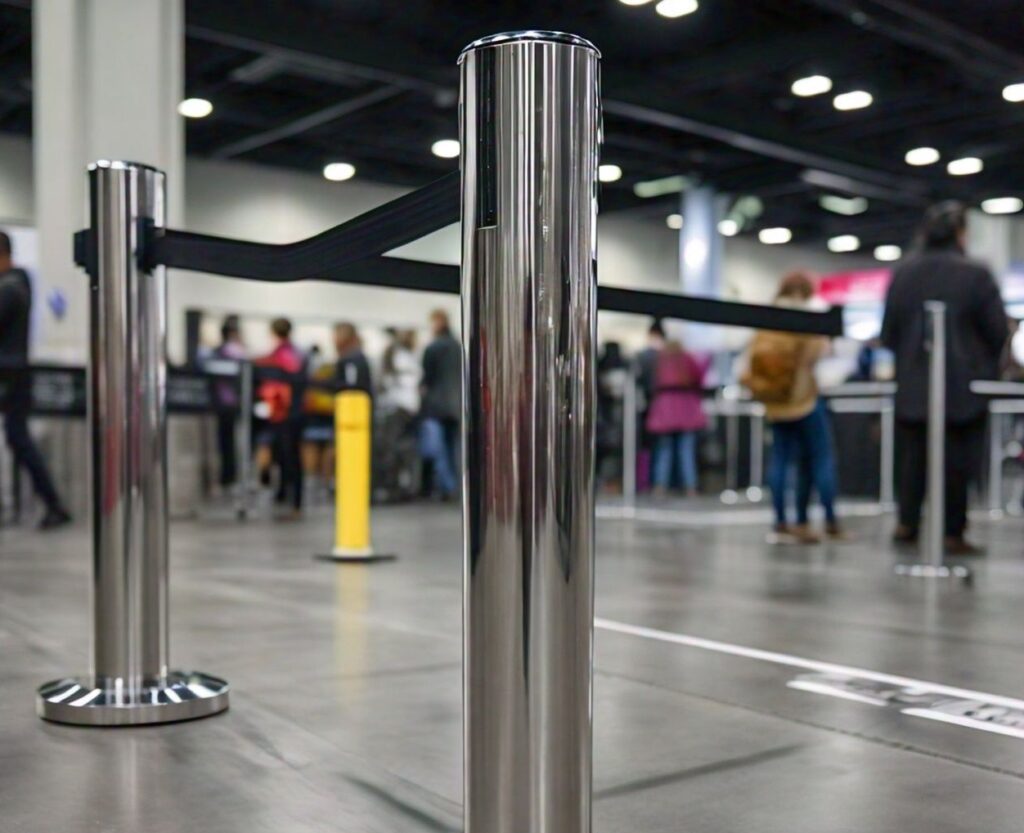Stanchions are a vital component in managing crowds and ensuring safety in various environments. From controlling queues to directing foot traffic, stanchions play a crucial role in maintaining order and efficiency. In this article, we’ll delve into the different types of stanchions, their applications, benefits, and more.
Introduction to Stanchions
Stanchions, also known as crowd control barriers, are upright posts typically connected by ropes, chains, or belts. They are commonly used in public spaces to guide people, create barriers, or mark boundaries. Stanchions serve multiple purposes, including crowd control, queue management, and safety enforcement.
Types of Stanchions
Rope Stanchions
Rope stanchions are elegant and often used in upscale settings such as museums, hotels, and theaters. They feature velvet or braided ropes attached to metal posts, providing a sophisticated look while effectively managing crowds.
Retractable Belt Stanchions
Retractable belt stanchions are versatile and easy to use. They feature retractable belts that extend from one post to another, creating a flexible barrier that can be adjusted as needed. These stanchions are commonly found in airports, banks, and retail stores.
Post and Chain Stanchions
Post and chain stanchion’s consist of metal posts connected by chains. They are durable and suitable for outdoor use, making them ideal for events, construction sites, and outdoor venues.
Key Features and Components
Stanchions typically consist of four main components:
Base: Provides stability and support for the post.
Post: Vertical upright that holds the barrier in place.
Belt/Rope/Chain: Connects the posts and forms the barrier.
Accessories: Optional add-ons such as signage, sign holders, and directional arrows.
Applications of Stanchions
Stanchion’s find applications in various settings, including:
Crowd Control: Managing large crowds at events, concerts, and festivals.
Queue Management: Guiding customers in lines at retail stores, banks, and ticket counters.
Event Management: Organizing and directing attendees at conferences, trade shows, and exhibitions.
Safety Barriers: Restricting access to hazardous areas or construction sites.
Choosing the Right Stanchion
When selecting stanchion’s, consider factors such as:
Environment and Setting: Indoor or outdoor use, aesthetic requirements.
Durability and Materials: Weather resistance, longevity.
Customization Options: Branding opportunities, color choices, accessories.
Benefits of Using Stanchions
Stanchion’s offer numerous benefits, including:
Improved Crowd Flow: Directing traffic and preventing congestion.
Enhanced Safety Measures: Creating barriers to restrict access to restricted areas.
Branding Opportunities: Customizing stanchion’s with logos and promotional messages.
Installation and Maintenance
Proper installation and maintenance are essential for the effective use of stanchion’s. Follow manufacturer guidelines for setup and regularly inspect and clean stanchion’s to ensure durability and longevity.
Creative Uses of Stanchions
Beyond their traditional applications, stanchion’s can be used creatively for:
Decorative Purposes: Enhancing the ambiance of events and venues.
Marketing and Promotion: Displaying advertisements or promotional material.
Art Installations: Incorporating stanchion’s into artistic displays or installations.
Cost Considerations
While stanchion’s require an initial investment, they offer long-term savings through improved efficiency and safety measures. Consider the cost of maintenance and replacement when budgeting for stanchion’s.
Common Mistakes to Avoid
Avoid these common pitfalls when using stanchion’s:
Poor Placement: Ineffective placement can lead to confusion or obstruction.
Neglecting Maintenance: Failure to maintain stanchion’s can result in damage or malfunction.
Underestimating Capacity: Using insufficient stanchion’s can lead to overcrowding and safety hazards.
Stanchions in Various Industries
Stanchions are widely used across industries, including:
Hospitality: Hotels, restaurants, and event venues.
Retail: Stores, shopping malls, and supermarkets.
Transportation: Airports, train stations, and bus terminals.
Entertainment: Theaters, stadiums, and amusement parks.
Environmental Impact
Consider the environmental impact of stanchion’s by opting for sustainable materials and recycling options. Choose stanchion’s made from recycled materials or those that can be easily recycled at the end of their lifespan.
Future Trends in Stanchion Design
The future of stanchion design is marked by:
Integration of Technology: Incorporating features such as sensors or digital displays.
Modular Designs: Stanchion’s that can be easily assembled, disassembled, and reconfigured.
Eco-Friendly Innovations: Sustainable materials and energy-efficient designs.
Case Studies and Success Stories
Explore real-world examples of stanchion applications and success stories in various industries.
Conclusion
Stanchion’s are indispensable tools for managing crowds, enhancing safety, and improving efficiency in public spaces. By understanding their types, applications, and benefits, businesses and organizations can make informed decisions when implementing crowd control solutions.
FAQs
Are stanchions only used for crowd control?
Stanchion’s have various applications beyond crowd control, including queue management, safety enforcement, and decorative purposes.
Can stanchions be customized with branding?
Yes, many stanchion’s can be customized with logos, messages, or colors to align with branding requirements.
Are stanchions suitable for outdoor use?
Yes, there are stanchion’s specifically designed for outdoor use, featuring weather-resistant materials and durable construction.
How do I determine the number of stanchions needed for an event?
The number of stanchion’s required depends on factors such as crowd size, venue layout, and specific requirements for crowd control or queue management.
What are some creative ways to use stanchions beyond their traditional applications?
Stanchion’s can be used for marketing and promotion, decorative purposes, and even as part of art installations, offering versatility beyond crowd control.







